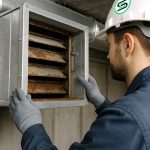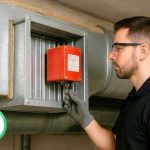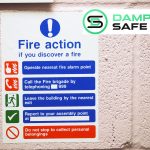Who Is Responsible for Fire Damper Testing in the UK?
 Introduction: Understanding Accountability in Fire Safety
Introduction: Understanding Accountability in Fire Safety
When it comes to fire damper testing in the UK, many organisations still ask the same crucial question: who is actually responsible? Whether you’re a landlord, facilities manager, or duty holder, misunderstanding your legal obligations can result in costly non-compliance — or worse, endanger lives.
Under UK fire safety law, the responsibility for fire damper testing is clearly defined, yet frequently overlooked in practice. This article clarifies where accountability lies, what the law demands, and how to ensure every test is documented and compliant.
The Legal Framework for Fire Damper Responsibility
The main legislation governing fire damper testing responsibilities in the UK is the Regulatory Reform (Fire Safety) Order 2005. This law places a clear duty on the “responsible person” to ensure that all fire safety systems, including fire dampers, are properly maintained and tested.
Depending on the type of building and its management structure, the responsible person may be one of the following:
- Landlords or Building Owners: Usually hold ultimate responsibility for ensuring fire safety systems are tested and maintained across the property.
- Facilities Managers or Managing Agents: Often act on behalf of the landlord to coordinate maintenance and compliance programmes.
- Duty Holders (Employers or Occupiers): Have day-to-day responsibility for ensuring the fire safety of their employees and visitors.
- Contractors or Testing Specialists: Are responsible for carrying out fire damper testing competently, in line with British Standards and industry guidance.
Ultimately, accountability for fire damper testing cannot be outsourced entirely — even when external contractors are used. The building owner or designated responsible person must ensure testing is completed and documented.
Fire Damper Testing Requirements in the UK
According to industry guidance and standards such as DW145: Guide to Good Practice for the Installation of Fire and Smoke Dampers and BS 9999, all fire dampers must be tested at least once every 12 months. Some high-risk environments — such as hospitals or care homes — may require six-monthly inspections.
Each test must include:
- Visual inspection and operational testing of every damper.
- Verification that dampers close fully and latch correctly.
- Cleaning and resetting of fusible links or actuators where required.
- Full reporting, including photographic evidence and test results.
Neglecting fire damper testing can lead to serious consequences, including prosecution under the Fire Safety Order, invalidated insurance, and enforcement notices from the Fire and Rescue Service.
Who Does What: Breaking Down the Roles
1. The Landlord or Building Owner
The landlord bears primary legal responsibility for ensuring fire damper testing takes place. Even if management is delegated to a facilities company, the landlord remains accountable for compliance under UK law.
2. The Facilities Manager
Facilities managers play a critical role in implementing a compliant maintenance regime. They must organise regular testing, select competent contractors, and maintain accurate compliance records.
3. The Duty Holder or Responsible Person
In workplaces, the employer or designated “responsible person” is accountable under the Fire Safety Order. They must ensure fire damper testing is included in the building’s fire risk assessment and maintenance plan.
4. The Contractor or Testing Provider
Competent contractors — such as Damper Safe Ltd — carry out testing, maintenance, and remedial works. However, their role is operational, not legal; they support compliance but do not carry the statutory responsibility.
To learn how testing is performed, read our detailed article Fire Damper Testing Costs Explained: Budgeting for Compliance.
Shared Responsibility and Documentation
In many multi-occupancy or complex sites — such as shopping centres or business parks — fire damper testing is a shared responsibility. Landlords manage the structure, while tenants or facilities teams handle internal systems. In these cases, coordination and documentation are key.
Every test must generate a formal report detailing damper locations, access routes, test results, and any remedial recommendations. The report should be stored centrally as evidence of compliance. Damper Safe Ltd provides comprehensive reports aligned with both CQC and insurer requirements.
How Damper Safe Ltd Supports Compliance
At Damper Safe Ltd, we work with landlords, facilities managers, and duty holders to deliver fully compliant fire damper testing programmes. Our services include:
- Annual and six-monthly testing schedules for all damper types.
- Detailed asset registers and photographic evidence for every damper tested.
- Maintenance and remedial works following DW145 standards.
- Support for documentation and compliance audits.
We act as a trusted partner to ensure that your fire damper testing responsibilities are met efficiently, transparently, and in full alignment with UK regulations.
To discuss your compliance obligations, contact Damper Safe Ltd for a professional consultation.
Conclusion: Clear Roles, Clear Compliance
Understanding who is responsible for fire damper testing in the UK is essential to meeting legal, safety, and insurance obligations. Landlords, facilities managers, and duty holders must all work together to ensure testing is scheduled, recorded, and performed by competent professionals.
By partnering with an experienced provider like Damper Safe Ltd, you can take the guesswork out of compliance and ensure your building remains safe, secure, and audit-ready.
For official reference, review the UK Government’s fire safety responsibilities guidance.















